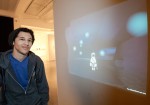On the distant, video-game planet of Poliphony, native creatures don’t communicate through spoken word or even body language, but rather through the sound of music.
“We wanted the score to convey a feel of magic. I wanted you to feel like you were exploring some really wondrous place; it wasn’t necessarily about excitement,” said Trevor Wilson, a third-year Design | Media Arts student and the game’s co-creator and sound designer.
“Poliphony,” borrowing its title from the name of the fictional planet as well as the polyphonic keyboard from which many of the game’s synthesized sounds were created, is a computer game developed by Wilson and two Design | Media Arts alumni, Heather Penn and Joshua Nuernberger.
Originally an assigned project in the students’ Gaming 2 class last spring, “Poliphony” was on display at the recent UV/UG Design | Media Arts Undergraduate Exhibition.
The game begins by dropping players next to what looks like a crashed lunar lander spaceship in an environment which includes shallow bodies of water, mountainous terrain and open plains littered with wild flora.
Prompted by little more than an overview of the movement controls and the ability to communicate with creatures through sound, players are left to figure out the meaning and purpose of the game themselves by exploring the planet.
“Poliphony” drew inspiration from video game titles like Thatgamecompany’s “Journey,” as well as from French author Antoine de Saint-Exupéry’s 1943 novella “The Little Prince,” Penn said.
Having read the novella before beginning the conceptual process for “Poliphony,” Penn said the chapter in which the Prince tamed a fox was creatively responsible for the first creature players come across in the game.
More Earth-like than alien, the fox, flying manta ray, mountain goat and heron all teach the player new music notes that are used to interact with specific ruins scattered around the planet. Once activated, these ruins create a change in music tempo and a small light show, signifying the celebratory success at completing the scripted tasks in the game.
Penn said these interactions between the player, planet environment and native creatures were intentionally vague because they added to the obscure meaning of the game’s narrative.
“I think we just wanted something … simple, (something) that communicated (the player’s character and creatures) were talking, but weren’t quite talking. We didn’t really want an overt story in our game,” Penn said.
The game creators worked off of each other’s personal design strengths.
Wilson said he took over the sound design duties because of his experience with musical instruments, including the harmonica, percussion instruments, guitar and keyboard.
Penn said Nuernberger did much of the conceptual work and game mechanic programming, whereas she took over as the 3-D modeling, animation and overall artistic expert, having taken classes on the subjects previously.
Chris Reilly, a teaching assistant for Gaming 2, said he noticed the group’s ability to create a cohesive project, something which he said added to the quality of the game.
“The three students definitely seemed to work really well together. … So I think it was a really good way for each of them to use their specialized skills together to make something that I think ended up being pretty successful,” said Reilly, a Design | Media Arts graduate student.
Although there is somewhat of a beginning and end to “Poliphony,” Wilson said he and the other creators were limited in what they could include simply because of the original class’s time constraints, having only six weeks to develop the finished product.
Penn also said the fast pace requirement allowed for little revision and fine-tuning after the initial idea was put into place.
“We just had to kind of commit to what we had done, and just go with it. … We didn’t really have time to reflect too much,” Penn said.
“I still feel like our final game, (if created during) a normal game process, probably would have been the first prototype.”
Even though all of the creators have since moved on from the project, both Wilson and Penn said they appreciated the experience, while the associate professor of Design | Media Arts and their Gaming 2 class, Eddo Stern, said he found “Poliphony” an impressive game because of amount of design knowledge that went into its creation.
“It’s generally pretty difficult to do the 3-D modeling and coding for a game, (while also) making sure things are working properly,” Stern said.
“And on top of that to have the overall play experience be something that’s engaging and actually meaningful, that’s a pretty difficult thing.”
Email Reid at creid@media.ucla.edu.
